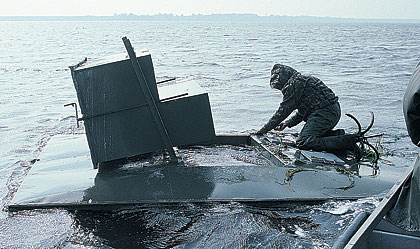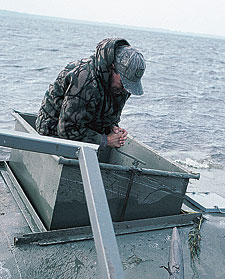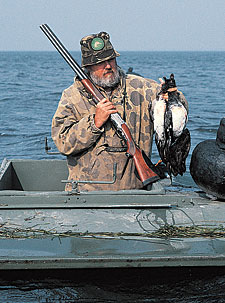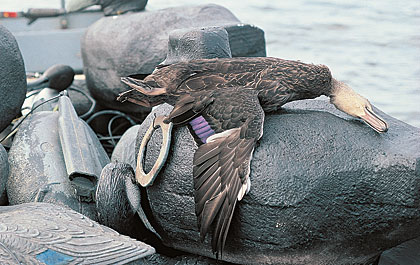November 19, 2010
By Worth Mathewson
A water's-eye view proves deadly in Quebec.
By Worth Mathewson
Lying flat on my back in the double battery, my eyes were just level with the wings. I could see the decoys bobbing it seemed for a hundred yards to leeward of us, though in reality, the outpost of them was but 40 yards. We were completely surrounded by decoys. Nothing but decoys, decoys, decoys -- brant, broadbill, redheads. Looking eastward, I saw a quick wedge of birds lifting sharply in the air, flaring first one white side, then the other to the sunlight, and pitch down close to the water. Then I ducked my head below the coaming of the battery and watched the Old Man's face -- saw his eyes roll around to the left, saw the fire leap into them, and heard the sharp sound of his voice: "Now!" -- Percy M. Cushing, 1912, Great South Bay, N.Y.
Good stuff, that. Back from the days that many of us sometimes wish we had seen for ourselves. But we can still experience battery shooting in Canada, where it is alive and well in some places. I first shot from a battery in the 1980s at Tabusintac Bay in New Brunswick, which was once a famous battery bay, principally for brant. Van Campen Heilner shot there, and is pictured doing so in his work, A Book on Duck Shooting. The Wishart family settled on a narrow point jutting into the bay and started guiding hunters in the 1880s. Their old log books read like the treasured pages of history that they are.
Advertisement
When we hunted there, brant no longer used Tabusintac. The batteries were used for Canada geese and black ducks, and Miles Wishart had nearly ceased offering battery hunting because of problems finding guides willing to go to the effort of setting them out. Battery shooting is labor-intensive. Also, he had found that few shooters were interested in the discomfort of lying on their back in a wet coffin for hours. Instead, they opted to shoot from shore blinds around the bay.
We were lucky. We had contacted Wishart solely for the batteries and were informed that he still had one guide, then-72-year-old retired lobster fisherman Prudent Thipadeau, who would go through the work of setting out a battery and the many decoys required. The year we were there, we were the only ones who had made a request for battery shooting.
Advertisement
For several cold mornings, my wife and I lay in two single-person batteries. The experience of having flocks of Canada geese, wingtips nearly touching the waves, come right to us at point-blank range without a clue we were waiting below the water line amounted to one of my all-time memories in waterfowling. So much so that I later arranged to have Wishart ship the battery I used to Vancouver, B.C. I drove up from Oregon to add it to my collection of waterfowl boats.
Not a Sinkbox
I'll admit there were times I wished I could have put the battery back in the water in Oregon. But the use of a battery was wisely outlawed in the United States during the 1930s, along with baiting, live decoys and unplugged guns. The reason was elementary -- they are too deadly on some species of waterfowl, principally divers, brant and geese.
 Black decoys, dark water and a classic battery sunk into the water form a traditional hunting scene. |
The old battery was made of wood, built in either a one- or two-man size. It was carried by a larger boat to the intended hunting location, anchored, then partly sunk with iron weights placed in compartments around the edge. The result was that the shooter was then actually lying below the water line.
The layout boats of today are similar, but as low-profile as they are, the hunter is still above the surface. Once set up and weighted down, the battery was nothing more than a floating pit blind that could be moved as needed. Such devices were once called nothing but batteries, yet for some reason, people began to call them sinkboxes. That is what I called them until recently.
 The sit-down compartment within the battery is cranked down for hunting and up when not in use and during transport. |
I was more than a little surprised to find out that while batteries are not legal in the United States, sinkboxes are. While nearly nonexistent, sinkboxes can be found on Pamlico Sound in North Carolina. Russell Williams at Hatteras, N.C., built one for clients he guides. Private clubs own the others in place in the Sound.
These sinkboxes, or "current blinds," as they are locally called, differ from the battery because they are permanently fixed to the bottom and can't be moved once built. They are made of concrete, poured at extremely low tide on high shoals. They are sit-down affairs, unlike most batteries in which you lie. The sinkbox fills completely with water at high tide and needs to be bailed out prior to each use.
Hunting is done on a rising tide. At full high tide, the hunt is over, as the water pours in. Like the battery, large wooden wings are on both ends, which serve to break the waves somewhat and are also where the hundreds of decoys are placed.
Actually, when I shot from Williams' sinkbox, I was farther under the water than I had been in Wishart's battery. The brant and divers were at eve level when they dropped into the decoy spread. It was memorable, something I wish I could experience on a regular basis.
Lake St. Pierre, Quebec
In October 2002, I received another opportunity. It wasn't from a sinkbox, but rather a battery. The location was Quebec, the guide Marcel St. Pierre. Batteries weren't outlawed in Canada, and in recent years, various guides have begun offering battery shooting, largely due to the increased interest in historical waterfowling. I assure you nothing is more worthwhile if your interests lean in that direction.
St. Pierre had contacted
me to ask if I wanted to come back and shoot from his batteries. I said yes, and he sent me a video showing some of the action, as well as the snipe and woodcock days he offers. After viewing the video, a trip with Marcel became first on my to-do list.
In the video, the heavy action pictured was based nearly solely around scoters, along with bluebills and oldsquaw (long-tailed duck for those who want to be politically correct). Incoming flocks in the video seemed close enough to fly down the barrels of the shooters' guns when they came up to fire.
Because I am an avid snipe hunter, I was most interested in combining battery shooting and snipe. However, although St. Pierre informed me that it could certainly be done, it would be at the expense of not having the best of the battery shooting.
He explained that the large diver population arrives in late October and early November, right before the freeze-up. The peak of the snipe shooting is in early October, when there is no shortage of puddle ducks -- black ducks, mallards, green-winged teal, wigeon and pintails. But puddle ducks don't work a battery nearly as well as divers because they fly higher. During early October, most, if not all, of his duck shooting is done from boat blinds near shore rather than far out in the open water with batteries. He told me that if I really wanted the snipe, we could still try putting out a battery to see what happened. That is what I decided to do, and I have no regrets.
 Although hunting from a battery is most effective for diving ducks that fly low to the water, it can be deadly for puddle ducks, too. |
St. Pierre is a commercial fisherman who fishes in Lake St. Pierre, which is situated 80 miles east of Montreal. The body of water is 35 miles long and 9 miles at the widest point, and it has long been famed for waterfowl, which hosts large numbers of Canada and snow geese.
Most of St. Pierre's clients come from France. When we arrived, a French shooter, Jacques Fiori, was there. He was an exceedingly congenial type, but persisted in talking to me nearly nonstop in French. He spoke no English. Since I don't do all that well outside basic English, I could only nod my head like my neck was unhinged. This worked most of the time, except when I nodded and apparently should have been shaking my head at what he said. About the only way I could counter was to suddenly interrupt him and blabber at him in English, thus putting him on the defensive. Fortunately, St. Pierre speaks excellent English, although I found talking in English isn't something that many people we encounter in Quebec do, or want to do.
St. Pierre's father made the metal batteries, in both two and one-man sizes. Each end has a plug so they can be filled with water and sunk to the desired depths. In order to raise them, the water is pumped out.
In the middle of the battery is a sit-down compartment, which is cranked down while hunting, then cranked back up when not in use or while the water is towed from place to place. Younger waterfowlers might like the lie-down type battery, but at my age, the sit-down style is markedly better.
 Success! A prized black duck lies amongst a collection of decoys after a day of battery shooting. |
Charged and Ready
As with all battery shooting, weather is critical. We luckily arrived just after a large blow, which would have made battery shooting impossible. We were to shoot Oct. 1 to 3.
In the predawn darkness on Oct. 1, our guide took Marge and me out into the vastness of Lake St. Pierre. He had set out a double-man battery the night before. A good wind was blowing, but the waves were small. St. Pierre cranked down the compartment, surrounded us with decoys, including three larger-than-swan-sized black ducks, and moved a quarter-mile away to act as tender.
With the first light, there certainly was no shortage of ducks. However, nearly all were puddlers, flying high and wary. When they circled overheard, they were able to look straight down at us. At that point, most started climbing that avian staircase in the sky -- fast. The limit was six ducks daily. I shot a morillon (bluebill), a canard noir (black duck), a sarcelle (greenwing) and a siffleur (wigeon). I also missed several good shots, which would have given me a limit in a little over an hour, had I hit them.
All three puddle ducks were taken with overhead shots as they cautiously circled. The bluebill came in dodging wave crests. That bird alone was worth the entire morning.
We spent the afternoon in St. Pierre's snipe marsh. Although it was the hardest walking I have ever done for snipe, it also provided the most flushes I have ever encountered, and that includes Louisiana and Ireland.
Unfortunately, it was also hot, with temperatures in the 70s. I had brought my extra-heavy chest waders for the battery shooting, so after a short distance, I was near collapse. I managed to kill two snipe before sweating to a halt. But St. Pierre and Fiori continued, returning later with a bag full.
The next day, I was back in the battery, this time with Fiori. Again, we saw a lot of ducks, but puddlers. Still, we ended up with seven, missing about that many as well. The bag comprised black ducks, greenwings, mallards, wigeon and a bluebill. That afternoon, with light waders borrowed from St. Pierre, I got my revenge on the snipe. There were clouds of them.
On our last day, the wind came strong, so there was no battery shooting. Instead, we hunted from a boat blind near shore. The action could have been better, but we ended with a Canada goose, a greenwing and three pintails. Things were better in the snipe marsh. St. Pierre and I hit full stride. With the aid of his old Lab, Tide, we flushed 50 to 60 per hour. Of course, some were re-flushes, but it was still an amazing concentration. We both shot well and came chugging out of reeds and thick mud with 18, two short of the limit.
Witness the Flurry
If I could do it again, and I think I will make plans to return, I would opt to go during the time when large numbers of divers are present. St. Pierre told me on most mornings, steady flocks stream into the battery. I want to see for myself. You might, too. If you are interested in perhaps the most thrilling way to hunt waterfowl, take heed. You are likely in for a hunting experience not soon forgotten.


Worth Mathewson of Amity, Ore., has written several books about waterfowl hunting that can be found in the Wildfowl bookshelf. This story is adapted from his latest, Waterfowling: Best Days.

